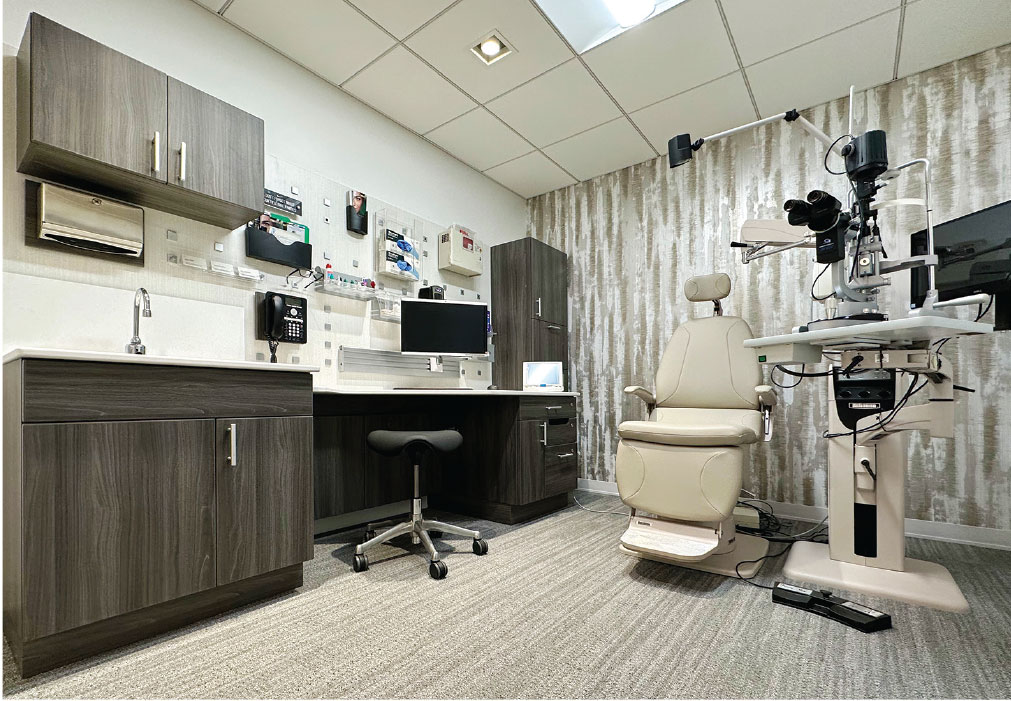OFFICE DESIGN
A Fresh Look for Exams
If your exam lanes are looking a little rough around the edges, EyeDesigns has launched a new line of exam room decor, called Orvos Exam Environments, that the company says may help make them more appealing.
 |
EyeDesigns says the Orvos exam systems are engineered with angled countertop cutouts that position the doctor within a 90-degree radius of the computer keyboard and other items on the desk, while still maintaining strong patient interaction. The company adds that this design decreases muscle fatigue and neck strain that can occur when moving from the patient to the computer and various instruments, makes use of an articulated computer arm that allows the physician to show the patient the monitor, and gives the physician easy access to the EMR system.
Orvos has designs for high-volume medical school teaching environments, hospitals and solo practices. The company’s available Smart Office system is designed to organize daily-use items like drops, tissues and paperwork in an effort to increase exam-lane efficiency.
For more information on the Orvos system, visit orvosexam.com.
DIAGNOSTICS
Topcon Ups the Tempo
If you’re looking for a middle-ground between headset-mounted perimeters and traditional desktop-based devices, Topcon’s new Tempo might be worth a look.
The Tempo uses an eyepiece reminiscent of the head-mounted devices and is suitable for use in ambient light, but in a desktop device that also employs many familiar testing protocols. The result, Topcon says, will make the process less stressful for patients, techs and eyecare providers—and 39 percent faster than standard automated perimetry.
Topcon highlights that the device is equipped with a binocular feature that can test the right and left eyes separately while it randomly presents the test object to either eye in a non-occlusion manner without the patient being aware of which eye is being tested. The company believes that, because patients don’t recognize which eye the stimulus is presented to, it’s been reported that this test method may be useful in the evaluation of functional VF loss, such as malingering or psychological disorders.
For more info, go to topconhealthcare.com/products/tempo.
B+L Brings Greater Efficiency and a New IOL
If you’re looking to give cataract patients’ intermediate vision a boost, Bausch + Lomb says its new enVista Aspire intraocular lens may fill the bill.
The company says the enVista Aspire combines novel optics, which are designed for a broader depth of focus, with the proven benefits of the enVista platform to address patient’s vision needs in today’s modern, digital world, calling it a “compelling new option for the many patients who use digital devices on a daily basis.”
For patients with astigmatism, the enVista Aspire also comes in a toric version. Featuring a low-cylinder design, enVista is the only toric IOL platform available to treat less than 1 D of astigmatism at the corneal plane, Bausch + Lomb says.
For more information, visit bauschsurgical.com.
Bausch + Lomb also recently launched SeeNa, an ophthalmic diagnostic system for refractive cataract patients that’s fully integrated with the company’s Eyetelligence surgical planning software to “help streamline surgical planning and information flow.”
Bausch + Lomb says SeeNa captures nine key measurements necessary for evaluating patients’ eyes before cataract surgery, and determining the cataract intraocular lens power calculation in one single step. It also offers a user-friendly interface, the company adds, allowing clinicians and staff to quickly master acquisition and operation and receive results in seconds.
SeeNa’s integrated Eyetelligence software connectivity allows for efficient upload of the measurements, enabling a seamless, secure flow of this data from the office to the operating room, Bausch says.
For more information, visit bauschsurgical.com/cataract/seena/.



